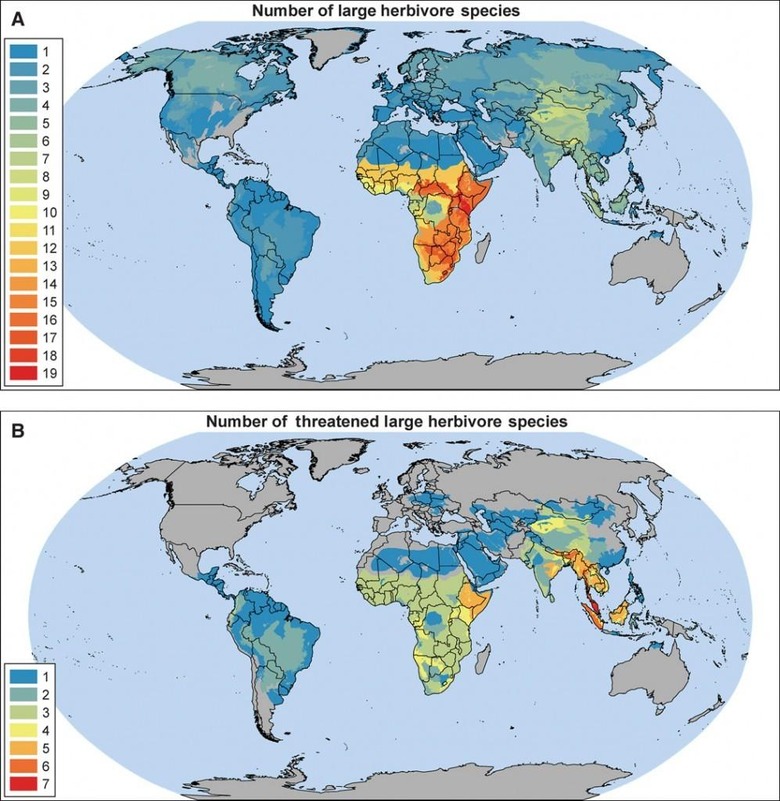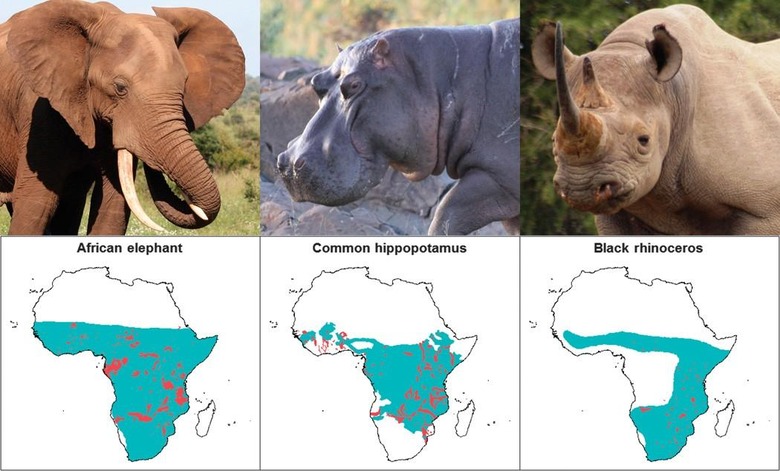Extinction of your favorite animal more real than you realize
This week a study published in Science Advances has suggested that the extinction of some of the world's most beloved animals is a clear and present danger. Fourty-four of the 74 largest terrestrial herbivores are now threatened with extinction, 12 of them "critically endangered" or extinct in the wild. Many of the species in decline, suggests the study, "are poorly known scientifically, and [are] badly in need of basic ecological research." Not only will they die unless we do something, we'll never know what they are all about in the first place.
Below you'll see a set of two maps. The map at the top shows areas where large herbivore species exist. The cool colors show places where large herbivores exist, but only a handful of species.
The warmer the color, the more species of large herbivore exist.

The second map shows where large herbivores are threatened. Save South America, most areas with very few large herbivore species seem to be less threatened.
The following species are currently threatened:
• African elephant (VU)
• Asian elephant (EN)
• Hippopotamus (VU)
• Pygmy hippopotamus (EN)
• Eastern gorilla (EN)
• Western gorilla (EN)
• Malayan tapir (VU)
• Baird's tapir (EN)
• Lowland tapir (VU)
• Mountain tapir (EN)
• Philippine warty pig (VU)
• Oliver's warty pig (EN)
• Visayan warty pig (CR)
• Palawan bearded pig (VU)
• Bearded pig (VU)
• Indian rhinoceros (CR)
• Javan rhinoceros (CR)
• Sumatran rhinoceros (CR)
• Black rhinoceros (CR)
• Grevy's zebra (EN)
• Mountain zebra (VU)
• African wild ass (CR)
• Przewalski's horse (EN)
• Asiatic wild ass (CR)
• Sambar (VU)
• Barasingha (VU)
• Père David's deer (EW)
• White-lipped deer (VU)
• Bactrian camel (CR)
• Indian water buffalo (EN)
• Gaur (VU)
• Kouprey (CR)
• European bison (VU)
• Wild yak (VU)
• Banteng (EN)
• Takin (VU)
• Lowland anoa (EN)
• Tamaraw (CR)
• Mountain nyala (EN)
• Scimitar-horned oryx (EW)
• Mountain anoa (EN)
• Sumatran serow (VU)
• Walia ibex (EN)
This study shows three of the best-known species whose populations are contracting as we speak. These herbivores are the African Elephant, the Common Hippopotamus (not common for long), and the Black Rhinoceros.

The most recent range polygons for the rhino are not shown here because of "recent poaching pressure."
The change in population and possibility of extinction in all of these areas is due largely to one (or more) of four elements. Exploitation (hunting), Livestock (problems therein), Land-use change, and Conflict – as in Civil Unrest between warring human factions.

Above you'll see the percentages of large herbivore species threatened based on these four major threat categories.
NOTE: The total here adds up to more than 100% because each large herbivore may have more than one existing threat.
Photo Credits: Elephant and hippopotamus (K. Everatt), rhinoceros (G. Kerley).
You can see the full study in Science Advances 01 May 2015: Vol. 1, no. 4, e1400103. Code DOI: 10.1126/sciadv.1400103. Authored by William J. Ripple, Thomas M. Newsome, Christopher Wolf, Rodolfo Dirzo, Kristoffer T. Everatt, Mauro Galetti, Matt W. Hayward, Graham I. H. Kerley, Taal Levi, Peter A. Lindsey, David W. Macdonald, Yadvinder Malhi, Luke E. Painter, Christopher J. Sandom, John Terborgh, and Blaire Van Valkenburgh.
The title of the paper this information comes from is "Collapse of the world's largest herbivores". This paper is available now for further review – again, from Science Advances.
